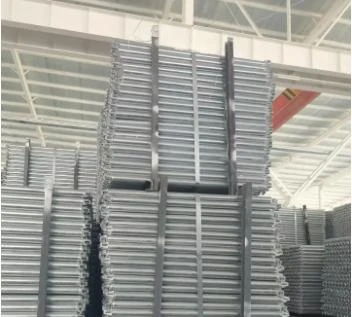
Fev . 15, 2025 15:17
Back to list
Scaffolding
Scaffolding plays an essential role in the construction industry, as it not only ensures the safety of workers but also facilitates efficient access to building sites of various shapes and sizes. This article will delve into the different types of scaffolding used in construction, drawing from authentic experiences and authoritative expertise to provide a comprehensive overview that enhances trust and credibility for professionals seeking robust scaffolding solutions.
5. Mobile Scaffolding The construction industry also sees immense value in mobile scaffolding systems, which are essentially supported scaffolds mounted on wheels. This type is highly beneficial for tasks requiring frequent relocation, such as finishing works or painting. Its primary advantage lies in mobility, allowing crews to move safely and swiftly between different areas of a site. An understanding of mobile scaffolding's proper use can significantly enhance project timelines and labor efficiency. 6. Cantilever Scaffolding Employed where ground support is either impractical or impossible, cantilever scaffolding is anchored to a structure at one end, leaving the opposite end free. This can be particularly useful in situations where scaffolding cant take up ground space. Expertise in cantilever scaffolding allows engineers and builders to solve complex problems associated with terrain and building design limitations. Safety and regulatory compliance underpin the scaffolding sector, making it crucial for all constructors, from novices to seasoned professionals, to engage with trusted providers and follow industry best practices. The effectiveness and efficiency of these scaffolding types highly depend on factors such as accurate installation, quality materials, and skilled craftsmanship. To assure adherence to high safety standards, it is imperative to partake in ongoing training and education, align with leading safety protocols, and stay informed about the latest technological advancements in scaffolding systems. Authorities and experts worldwide continue emphasizing these components, providing guidelines and updates aiming to foster a safer working environment for construction professionals. Whether operating on a large infrastructure project or a simple residential build, choosing the appropriate scaffolding type can optimize outcomes, safeguard lives, and ensure project success. By combining a thorough understanding of each scaffold type's specific benefits and limitations with expert guidance, the construction industry can continue to build not only structures but a stronger, safer industry standard globally.


5. Mobile Scaffolding The construction industry also sees immense value in mobile scaffolding systems, which are essentially supported scaffolds mounted on wheels. This type is highly beneficial for tasks requiring frequent relocation, such as finishing works or painting. Its primary advantage lies in mobility, allowing crews to move safely and swiftly between different areas of a site. An understanding of mobile scaffolding's proper use can significantly enhance project timelines and labor efficiency. 6. Cantilever Scaffolding Employed where ground support is either impractical or impossible, cantilever scaffolding is anchored to a structure at one end, leaving the opposite end free. This can be particularly useful in situations where scaffolding cant take up ground space. Expertise in cantilever scaffolding allows engineers and builders to solve complex problems associated with terrain and building design limitations. Safety and regulatory compliance underpin the scaffolding sector, making it crucial for all constructors, from novices to seasoned professionals, to engage with trusted providers and follow industry best practices. The effectiveness and efficiency of these scaffolding types highly depend on factors such as accurate installation, quality materials, and skilled craftsmanship. To assure adherence to high safety standards, it is imperative to partake in ongoing training and education, align with leading safety protocols, and stay informed about the latest technological advancements in scaffolding systems. Authorities and experts worldwide continue emphasizing these components, providing guidelines and updates aiming to foster a safer working environment for construction professionals. Whether operating on a large infrastructure project or a simple residential build, choosing the appropriate scaffolding type can optimize outcomes, safeguard lives, and ensure project success. By combining a thorough understanding of each scaffold type's specific benefits and limitations with expert guidance, the construction industry can continue to build not only structures but a stronger, safer industry standard globally.
Share
Next:
Latest news
-
The Importance of Reinforcement Bar in ConstructionNewsJul.11,2025
-
The Durability of Timber Steel FurnitureNewsJul.11,2025
-
How to Assemble Fixed Clamp Scaffolding SafelyNewsJul.11,2025
-
Essential Column Rebar Specifications for High-Rise BuildingsNewsJul.11,2025
-
Common Applications of Steel Keels in ConstructionNewsJul.11,2025
-
Benefits of Using Aluminum Scaffolding Ladders Over SteelNewsJul.11,2025
-
Stainless Steel Keel: Analysis of the Triple Advantages of Rigidity, Stability, and LightweightNewsJun.19,2025
Related Products










